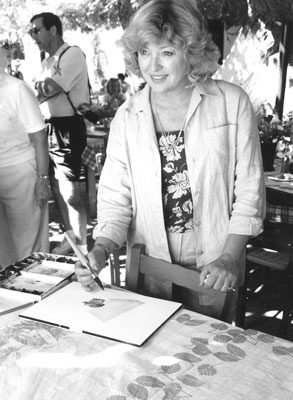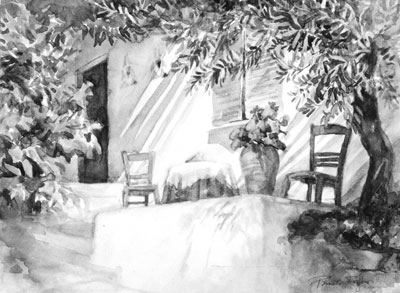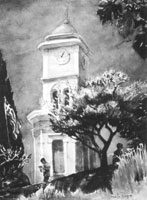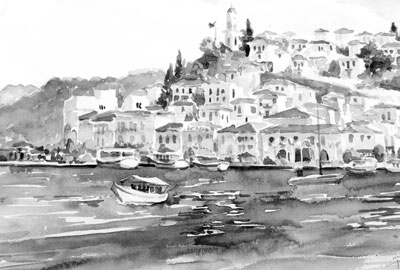A tranquil Greek isle as seen through the eyes of an artist
by Rod King, New Haven, IN
Motoring into the harbor at Poros, Greece, on the Anna II from Athens, I was excited to see that it was as picturesque as I had envisioned it. The bright afternoon sun reflected off the white and cream houses on the hillside, giving them a freshly painted look. The spire of the Church of St. George and the town’s clock tower stood out above the orange tile roofs.
Along with other members of the Alumni Campus Abroad group, organized by Alumni Holidays International (AHI, 6400 Shafer Ct. Rosemont, IL 60018; phone 800/323-7373 or visit www.ahitravel.com), I edged to the bow to snap photos. We were going to spend a week on this little bit of Greek soil (13 square kilometers) in the Saronic Gulf visiting ancient ruins and learning about the island, Greek culture and mythology.
Art imitates life
As we walked along the hallway to our room in the Hotel New Aegli, I noticed on the walls a number of eye-catching watercolor scenes of the town and its surroundings and was greeted with a large painting over my bed of the same view I had photographed not 20 minutes earlier. Like the ones in the hall, this painting of the broad waterfront scene was signed with a name that strangely rang a bell, Pamela Rogers.
It took a bit, but it finally registered that this was the same person who had introduced herself to us at the dock as Campus Director of the AHI program and who made sure we got into taxis headed to the hotel and got into our rooms. I found more of her paintings in the hotel restaurant. It was a visual travelogue of the island.
During my week on the island, I kept coming upon places I had seen in Rogers’ light, airy watercolors. Some were of the broad expanse of the Poros harbor from various angles, while others zeroed in on the microcosm of a narrow street, a single rowboat tied to the shore, a colorful explosion of bougainvillea growing up the side of a building or a simple window with bright blue shutters. She also captured the sparkling white clock tower, taking in all the comings and goings in the harbor from its strategic setting at the top of the hill overlooking the town.
This North Carolina native has been living and painting on the island for the past 12 years.
“Poros offers a world of painting possibilities,” she says. “There’s absolute beauty everywhere.”
Rogers, who enjoys painting on location, heads out on her moped to catch the morning light around
8:30 a.m. and in a couple of hours has a finished piece. Sometimes finding another scene requires no more than turning in another direction or retreating a couple paces for a totally different view. She has created more than 2,000 paintings of Poros and says, “I don’t think I’ll ever run out of scenes to paint.”
The island
Poros, which has about 4,000 residents, lies just 300 yards from the Greek mainland, a 5-minute ferry ride from the even smaller (and not nearly as picturesque) town of Galatas. The island is split into two sections by a little canal. The largest section, Kalavria, is a limestone rock covered by pine forests, while the town of Poros (the only town on the island) covers most of the smaller, volcanic part (Sferia), lovingly referred to as the “lamb chop” because of its shape.
Unlike some of the other Greek islands, Poros is not a major tourist destination but rather the place where Athenians come to take refuge from the fast-paced city life.
There are more water taxis than auto taxis on Poros, and mopeds and motorcycles are the transportation of choice here, where the sun shines 300 days a year. Narrow cobblestone streets snake their way uphill between the houses, and steep steps lead back down to the waterfront.
There’s no mistaking the pharmacy, which has paintings around the front door representing the ancient Greek goddess of good health, Hygiea.
St. Nicholas Church, crammed among houses on a little alley street, is a one-story structure that contrasts greatly with the Greek Orthodox Church of St. George farther up the hill with its bell tower and massive wooden door. The pristine, white Fisherman’s Church sits at the water’s edge outside of town with a steep rock formation serving as a backdrop. There are about 150 such chapels on Poros Island.
Small shops crowd the little streets closest to the waterfront, and the meat/fish market can easily be located by following your nose. There’s no shortage of places to eat on Poros, with more than 70 tavernas. Awning-covered outdoor restaurants jammed side by side along the harborside street offer a variety of Greek specialties and a good view of the passing parade of sailboats, yachts, hydrofoils, fishing boats, ferries, water taxis and the fluttering flags of 15 nations.
The town center, also at the water’s edge, is marked with a 20-foot-tall marble obelisk topped by an eagle of Zeus, and another a block away honors Poseidon with his trident and a dolphin.
Nearby sights
The Monastery of the Life-giving Source (Zoodochos Pighis), established between 1713 and 1720, can be seen across the bay from the back side of the “lamb chop” and is just a short ride away.
Tall cypress trees reach skyward from within its high, white walls. The intimate chapel is ornate yet simple. Outside, villagers and visitors line up at the spring of the immortal water for a taste of its healing fluid.
Just five kilometers from town on the same road as the monastery, on a high plateau overlooking the sea, lie the remains of the Sanctuary of Poseidon dating back to the sixth century B.C. Only the foundations of the temple and other buildings remain. Though most of the building blocks were used by islanders throughout the centuries for the construction of churches, archaeology buffs will be able to get a good feel for the size of the structures and enjoy a nice view across the bay to the Peloponnese.
Like visitors with cameras pressed to their faces, Rogers has been inspired by the multitude of scenes on Poros. Her images have captured, for others to enjoy, the fabric, culture and lifestyle of this laid-back little island.





